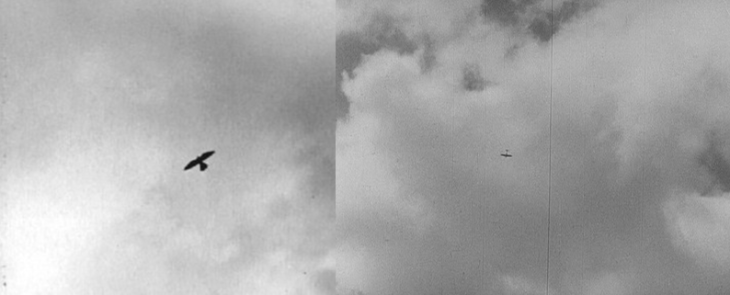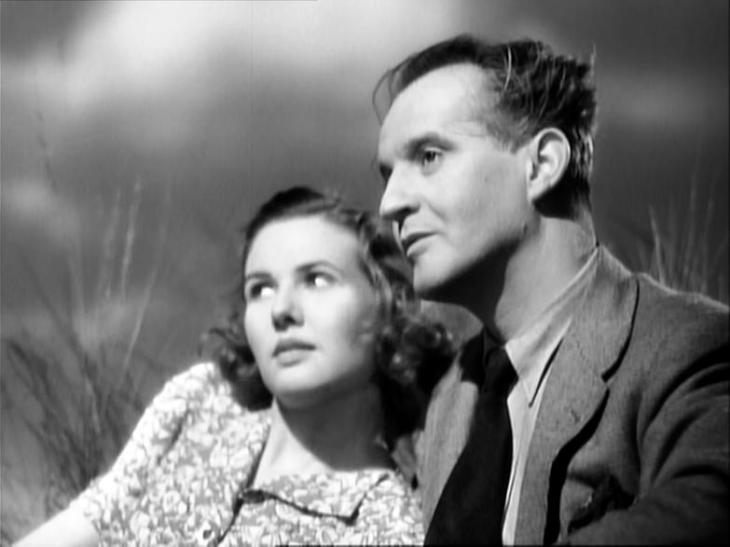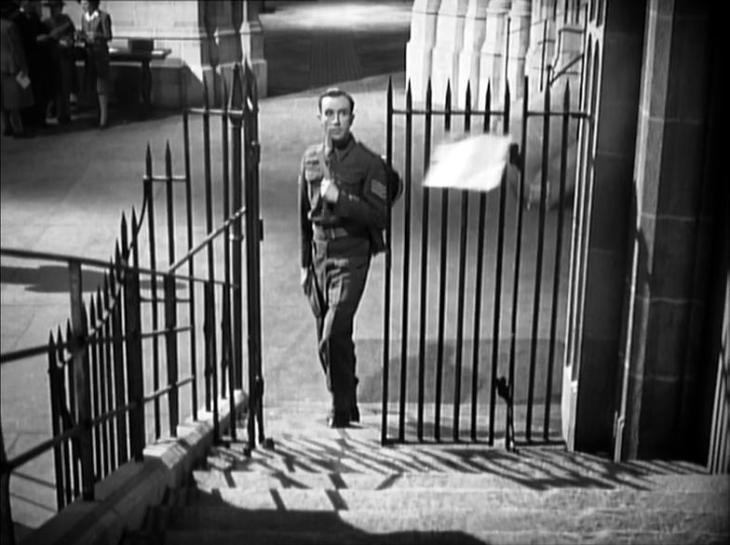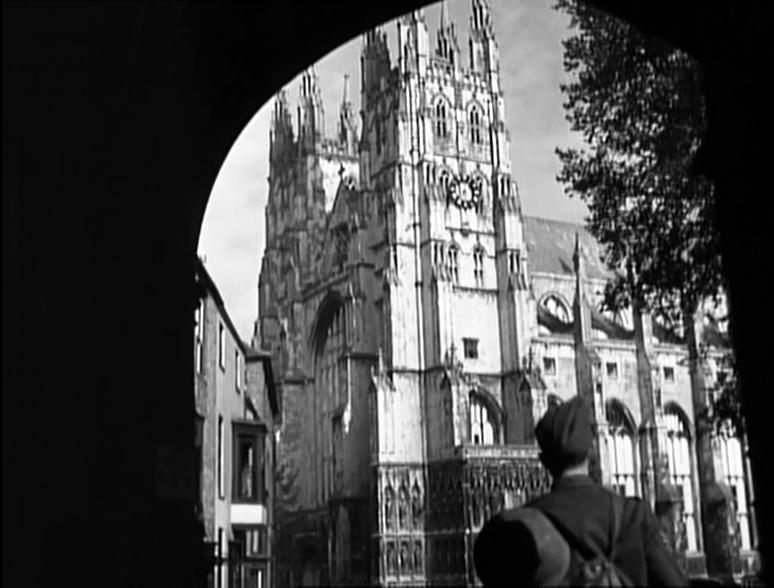Not much happens during the two-hour running time of A Canterbury Tale. An American sergeant travelling to Canterbury gets off the train at the wrong stop, and is forced to stay in the small town of Chillingbourne. While there he teams up with a British sergeant and a young woman to find the identity of a mysterious assailant called The Glue Man, who pours glue over the hair of British girls who date American soldiers. Later the three companions travel to Canterbury where a final miracle is waiting for them.
Such is the storyline, but the story is sometimes the least important part of a movie that is made with thoughtfulness, intelligence and great skill. What A Canterbury Tale lacks in narrative drive, it makes up for with its brilliant visual style and its rich literary, historical, contemporary and spiritual subtext.
While the film is called A Canterbury Tale, most of the action takes place before the characters arrive in the city. Indeed only the final 20 minutes of the movie are set in Canterbury. Nonetheless the town looms large over the action. It is constantly referred to by the other characters, and we get glimpses of the distant city, with particular focus on its imposing cathedral.
The title carries a deliberate echo of The Canterbury Tales, a collection of verses written in story form by the medieval poet, Geoffrey Chaucer. Indeed the film opens with the pilgrims from Chaucer’s tale. We watch as they travel along the Pilgrim’s Way, the road that leads to the cathedral, where they will seek blessings. While we watch their antics, a narrator quotes from Chaucer’s work, or perhaps an imitation of Chaucer’s style.
However this is not a medieval tale, and this scene is designed to link the past and the present, both by similarity and by contrast. Soon we will see three modern pilgrims finding a blessing at Canterbury, but the Pilgrim’s Way changes much over that time.
The transition from the past takes place while we watch a hawker release his bird. He looks up at the bird and we watch it soar in the sky. The scene abruptly cuts to the present-day (1940s Britain). The sky-borne hawk has become a fighter place, and the hawker is replaced by a soldier, who gazes up at this modern invention in the same manner.

The scene anticipates a similar and more famous time transition in Stanley Kubrick’s 2001: A Space Odyssey, but director Michael Powell used this image 20 years before Kubrick. In Powell’s case, this is accompanied by a continuation of the narrator’s poem, only now the verses have been updated to reflect present-day realities. The narrator intones:
The Pilgrims’ Way still winds above the weald through wood and break and many a fertile field. But though so little’s changed since Chaucer’s day, another kind of pilgrim walks the way.
This pilgrim is a tank that trundles along the road. A World War is going on. The field and wildlife may have changed little, but human affairs have moved on since Chaucer’s age.
The shadow of war hangs heavy over the film. World War 2 was still not over when it was made. Soldiers are carrying out military exercises, characters are warned about the blackout, tyres have been requisitioned for military usage, and even the local children are playing war games.
Two of the three leading characters are soldiers, the American Bob Johnson (John Sweet), and the British Peter Gibbs (Dennis Price). The other character is Alison Smith (Sheila Sim), and she is a Land Girl, a member of a civilian organisation that employed women to work in agriculture to replace male workers who were fighting.
War is also having an adverse effect on the lives of the three characters. Bob is waiting for letters from his sweetheart back home, but the long gap since her last correspondence makes it seem increasingly unlikely that her letters have been lost. Alison’s boyfriend is a pilot who has been reported missing in action. At the movie’s end, Peter Gibbs’ unit is called on to fight again, and he leaves to return to the front.
War is also the motive behind The Glue Man’s attacks. The culprit is not hard to guess. He is suspected from the beginning when the three protagonists follow him back to the place where he is staying. Even his name bears a slight resemblance to the word ‘culprit’. I am revealing no great twist in the movie if I tell you that it is Thomas Colpeper, a local farmer and magistrate.
The film’s treatment of Colpeper is curious. In the average film, Colpeper would be a outright villain, and we would wait for him to be apprehended. Indeed Colpeper does have many objectionable qualities. He carries out his attacks using an American uniform in order to discredit the American soldiers. His attitudes towards women are somewhat dubious. When he points to an old ducking stool, he explains that it was, “Very sensibly used for silencing talkative women”. In line with this prejudice, he refuses to employ Alison.
Yet for all his conservative and narrow-minded opinions, the film encourages us to like him. He is a cultured man who holds slide shows to celebrate the local history of his home. Indeed Alison finally wins him over by showing that she shares his interest and donating an old coin to the museum. He later relents and apologises for misjudging her.

By the time Colpeper has been unmasked by the investigators, he has won their affections, and they are reluctant to report him to the authorities. He is allowed to explain his reasons for throwing glue in women’s hair. He sees himself as a missionary trying to spread knowledge, and he feels distaste for young women who are betraying their lovers fighting away from home by dating the American soldiers.
Colpeper does not object to being tried by the justice courts because he thinks, “There are higher courts than the local bench of magistrates”. Here he gazes towards the cathedral, so we know that he is not thinking about earthly courts.
Such reasons hardly seem acceptable to justify Colpeper’s behaviour, even though we are clearly supposed to feel that they should. Colpeper seems to be in touch with something elemental and British – he loves the countryside, he loves his country’s history, and he has a spiritual understanding which anticipates the film’s miracles in the final act. We can also add that his act is a bad one, but more of a nuisance than a danger. Glue soon washes out. Nobody is hurt by his actions.
There is a reason for the long pastoral interlude before our heroes return to duty. It allows Michael Powell to celebrate what it is to be British during a time of war – literature, history, music, and of course the countryside. These are the things that we are fighting for. Our heroes emerge from the experience rejuvenated, even the country-hating Peter Gibbs.
A love of his country does not mean that Powell has a narrow-minded dislike of other countries however, and a large part of our experience of Chillingbourne is seen through the eyes of the American sergeant, Bob Johnson. Bob was played by a real American sergeant called John Sweet.
While Sweet is no professional actor, his amateurism adds a naïve naturalness to his performance. One might say he is Sweet by name and by nature. His character is very charming, and the actor himself had many good qualities. He donated the wages that he earned for making the movie to the National Association for the Advancement of Colored People.
To some extent Bob is a fish out of water. His American background leads to a number of gently comical misunderstandings. The locals cannot understand why his sergeant’s stripes are the wrong way up. When he asks about crime in the area, he is crisply told, “This is Chillingbourne, not Chicago”. He bemuses the locals by calling a shilling a quarter and a grocer’s a drug store. He cannot understand the British love of tea, which he detests.
However his amiability soon makes him friends, not least among the local children who help him in his quest to find The Glue Man. He is also at home with some of the local farm workers because he comes from an agricultural background himself. For once he finds himself talking the same language as the locals, and he is invited to dinner.
Finally our heroes set off to Canterbury. We do not see the city until the film’s last half hour, but from this point onwards Canterbury Cathedral towers over every scene. It is either in the background as the characters move along the streets, or else we are actually inside the cathedral itself.
I say inside the cathedral, but this is a misleading description. The cathedral was closed for repairs at the time, and Powell was only able to get one sneaky shot of the inside. What we have for the main part are studio sets that brilliantly recreate the setting. With the use of careful props and clever positioning of the camera, we receive the illusion that the action really is taking place inside the cathedral. Indeed some cathedral guides have mistakenly told people that A Canterbury Tale was filmed there.

The positioning of the Cathedral is important because the last act of the film is one of fantasy and wish fulfilment. It has been anticipated earlier. The inn at which our characters stay in Chillingbourne is called Hand of Glory. Alison thinks that she can hear music from the travellers of old on the Pilgrim’s Way, and Colpeper confirms that he has heard it too. As the train pulls into Canterbury, a light forms an apparent halo over Peter’s head.
Colpeper thinks that even latter-day pilgrims can receive blessings from Canterbury Cathedral, and this proves to be the case. Each of the characters harbours a personal sadness, and this is about to be put right under the seemingly magical influence of the cathedral.
As I have said, Bob is missing his girl back at home who has not written for seven weeks. This is put right when he meets an old friend in a tea shop opposite the cathedral. As Bob complains about his girl’s failure to send him a letter, his friend teases him, “Hey, do I look like a heavenly messenger to you?” before handing him her overdue letters. It seems that she has joined the WACs (Women’s Army Corps), and is in Australia, hence the delay in writing.
The fate of the other two characters is even more moving. While Peter has become an army sergeant by circumstances of war, his peacetime profession was playing the organ in a cinema. However his real aspiration had always been to play a church organ, and this seems in danger of being unfulfilled.
While seeking the police superintendent to report Colpeper, Peter enters the cathedral just as the cathedral organist is ascending the steps to play the instrument for service. Peter is unable to help speaking to a fellow-organist and the grumpy organist soon melts when he sees Peter’s obvious interest. He allows Peter to play tunes on the organ ahead of the service, and Peter is so absorbed in fulfilling his life’s dream that he loses interest in reporting Colpeper.
Meanwhile Alison is seeking out a caravan. This is the caravan she owns with her boyfriend who is now missing in action. She has fond memories of Chillingbourne, as she and her boyfriend stayed there in this caravan. The journey to find it again proves to be an emotional one. Many of the streets have been levelled by the war, and everything has been relocated.
When Alison finally finds the caravan, she is horrified to see that its tyres have been requisitioned, the caravan is covered in dust, and moths are eating everything. The last link to her romantic past is being taken away from her. However her sadness is brief. She learns that her boyfriend’s father is waiting for her with news that her lover has turned up alive in Gibraltar.
So the film ends on a happy and fantastical note, although the future for our heroes is uncertain. The war continues, and Peter must leave to fight. Appropriately the tune to accompany his leaving army unit is ‘Onward, Christian Soldiers’, reflecting the movie’s themes well.
The film cannot finish with a perfect resolution of everyone’s situation, because the war was still going on at the time when A Canterbury Tale was released. However the final image is a hopeful one. As the credits play, we see that the children have stopped playing at soldiers, and are now playing football.
A Canterbury Tale opened to poor critical reviews, and was less successful than earlier Powell and Pressburger collaborations. Perhaps that is because it is an acquired taste and not for everyone. It is unashamedly highbrow, and more interested in creating a mood than in generating suspense. For those of us who do appreciate A Canterbury Tale however, it is sublimely beautiful and moving. Watching the film is an enriching experience.

A multidimensional film, such is as real life.
LikeLike